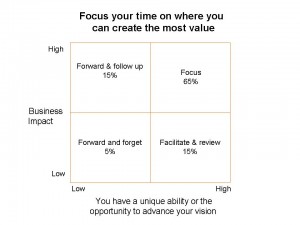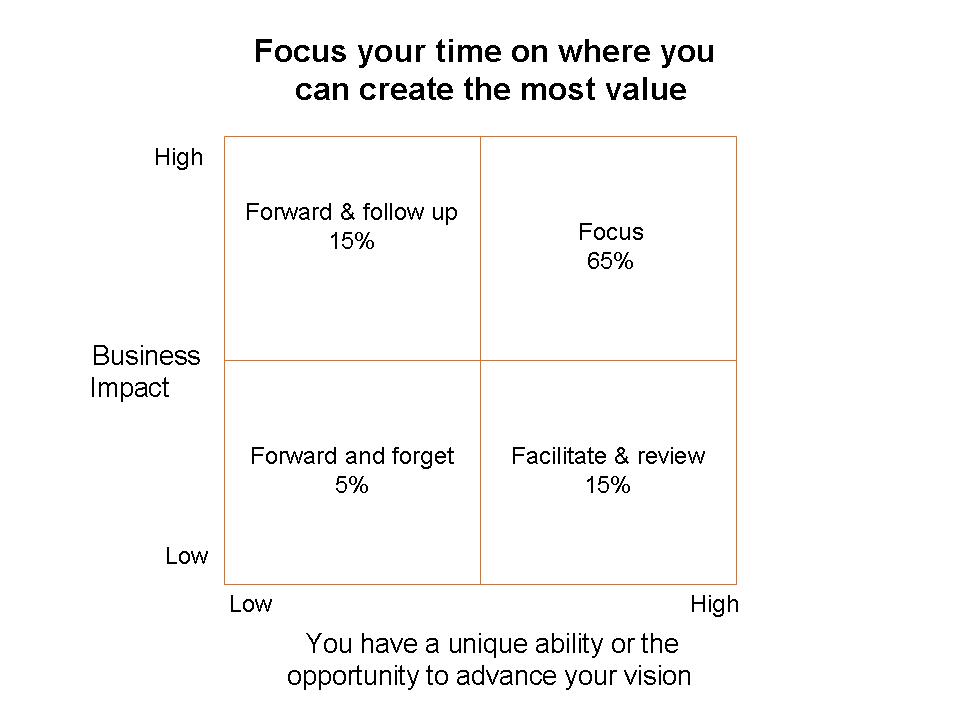How much of your time is really spent on value-added work? If you are familiar with the Pareto Principle the best guess is about 20%. Commonly referred to as the 80/20 rule, the Pareto Principle states that 80% of outputs in a system are generated by 20% of inputs.
Look at your own business and you’ll find the 80/20 rule in action. 80% of your revenue comes from 20% of your customers. 80% of your sales come from 20% of your sales force. When I worked in the training and development group for a large company, we even found that about 80% of all training course completions came from around 20% of the courses we offered. It is important to note that the Pareto principle is not an exact law but a principle. You won’t always find perfect 80/20 distributions. The point is that a lot is often created by a little.
It follows that our personal resources, if left unmanaged, will probably also tend toward he 80/20 rule. That is, 20% of our effort will create 80% of the value. So what are you doing with the other 80% of your time? Many people tell me they are working harder and longer than ever. Yet, I wonder if they are producing substantially more value? I’ll go with Pareto and guess probably not.
How can I increase my contribution without working 100 hours per week?
Your greatest impact comes from doing things that create direct business impact or or for which you have a unique ability.
The first step is to understand what falls within each of those categories. You can find what is essential and strategic by looking at your organization’s strategy, performance metrics or annual goals. Alternatively, look at those things that directly touch your customer or income stream versus those that simply support it. If you aren’t sure where your unique ability lies, you might want to consider reading my earlier post, “What’s so special about YOU anyway.”

Comparing business impact and your unique strengths results in four priority levels.
Focus (High business impact/Uniquely qualified)
Forward and forget (Low business impact/Not uniquely qualified)
Forward and follow-up (High business impact/Not uniquely qualified)
Facilitate and review (Low business impact/Uniquely qualified)
Use this chart to prioritize the work you do. Your goal is to shift from having 20% of your effort produce 80% of your value to having 80% of your effort focused on the 20% most critical areas where you can add value.
Focus
Ideally you should spend the most time in activities that generate business impact AND for which you have a unique skill. Spend 65% (26 hours per week) of your time here. Not only will you create more value for your organization, you will also differentiate yourself more effectively.
While this sounds good, it may not be as easy as it seems. Remember, according to the Pareto Principle, you are probably only spending about 20% of your time there now. The first thing that you need to do is free up some time. The remainder of this article will talk about how to handle requests that fall outside of this box.
Forward and forget
The biggest non-value added draw on your time comes from doing things that provide little business impact AND for which you do not have a unique ability. Yet, that is where most “busy” and administrative work falls.
How often do you find yourself doing these tasks? You’d probably be surprised if you stopped and documented your time. You should set a goal to only spend 5% (2 hours per week) of your time here. Most people have a strong reaction to that target. They tell me that they can’t possibly limit their time to 5%. They get too many requests that fall within this bucket. It’s not that we can’t get rid of these tasks, we often don’t think to do so. They are deceptive. They come in small packages. They might take fifteen minutes or a half hour. However, when added up they suddenly eat away 80% of your week.
Some of these tasks are administrative in nature. Getting them off of your plate will probably be a relief. However, sometimes these tasks masquerade as opportunities. They are the “quick favors” that people request. As a result, they provide almost immediate positive reinforcement. We all like to help out and be heroes.
The problem with this type of work is that while you might be a hero for the moment, their impact quickly fades leaving you with a lot of friendly accolades but no results.
The most effective way to deal with these types of requests is to forward and forget them. Find the person who is best suited to respond and let that person take over. Be sure to inform the person who made the request that you have forwarded it to the proper channel. Let them know that they should follow up directly with that person moving forward. Then, let it go; you’ve done your job and added as much value as you should. Remember, it wasn’t that important in the first place.
Forward and follow-up
Another time trap that people often fall into is getting too involved where they aren’t needed. Clearly, certain high priority items need your attention. They are a great way for you to add value, demonstrate your commitment to the organization, and build credibility. However, you don’t always have to get deeply involved in order to ensure their success. This is especially true when there are other people who can do the job as well or better than you.
In these situations a better option is to forward and follow-up. You should spend about 15% (6 hours per week) of your time here.
First, find out if there is someone who is better to lead the effort. If so, transition the responsibility. However, stay informed about the effort and follow up to see if your help is needed.
If you can’t find someone else lead it yourself but stay out of the details. Find the people who can get the job done. Then, use your time strategically by:
· Holding them accountable for deadlines
· Making yourself available to help resolve issues or provide guidance
· Serving as the point person between the team and the person who made the request
These are activities for which you can add most value without absorbing all of your time.
Facilitate and review
The final time sink is activities that are interesting to us but don’t have a lot of business impact. It’s easy to get lost in our individual passions and causes. Therefore, the first question that you must ask yourself is whether you should even focus on activities when they fall within this category.
However, sometimes there are good reasons to focus here. For instance, suppose that you have a unique skill at product development. You’ve developed a unique process that is generating value but you are the only one who understands it.
You may decide that it is worthwhile to run the process on a small customer segment. While the segment might not be as valuable to the overall organization, it could be a good opportunity to teach others the process in a relatively risk-free manner. However, as with forward and follow-up, don’t spend more than 15% of your time here.
As with forward and follow up, the goal here is to have other people do most of the work. Where this differs is that the other people are not equal to or better than you at the task. Therefore the nature of your activity is different. In this case, your role is to facilitate and teach.
Be sure to scope the effort in such a way that there is enough time for others to make mistakes and learn on the job. Then let the team do most of the planning and execution. You provide feedback and structure throughout the process, but again, stay out of the details.
Not all tasks are created equal
Take the first step today. Figure out how you are spending your time. Write down all of your activities for a week and the amount of time you spend on each. Then, for each activity indicate whether the activity had high or low business impact and whether you were uniquely qualified to perform it. Tally up the amount of time you are spending in each quadrant of the model. Then, adjust accordingly.
If you follow the 65/15/15/5 guidelines as suggested you will find that you spend 80% of your time in areas that have high business impact or for which you have a unique contribution to make.
You only have a limited amount of time to contribute to your organization. There will always be more demands on that time than you can handle. If left unmanaged, your time, effort, and impact will inevitably fall prey to the Pareto principle.
Resources
For a more detailed explanation of the Pareto Principle see:
http://en.wikipedia.org/wiki/Pareto_principle
http://management.about.com/cs/generalmanagement/a/Pareto081202.htm
For more on the 80/20 rule and additional resources for incorporating it into your work see:


